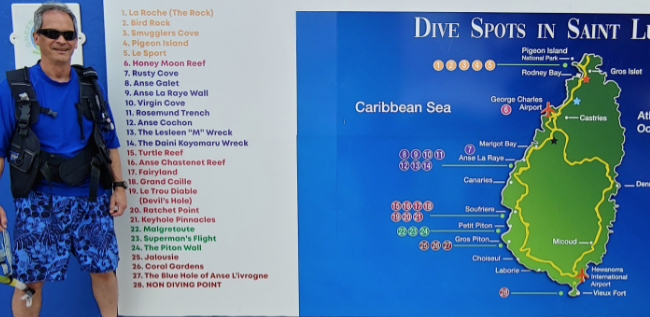By Corrine Holmes
St. Elizabeth Healthy Headlines
When Gary Fabre walked into his doctor’s appointment at St. Elizabeth Healthcare in July 2020, he assumed he was only catching up on routine primary care that had been delayed by the pandemic. He felt fine, so what he learned came as a big surprise.
“I just went in for an annual check-up. After listening to my heart, my doctor told me I had a heart murmur,” says Fabre, 60, who has been an avid scuba diver since 1994. “I never knew I had a heart murmur, and I didn’t know much about them.”
He isn’t alone — heart murmurs are not uncommon. Approximately 10% of adults have one. Most murmurs go unnoticed until a doctor listens to a patient’s chest with a stethoscope. A normal heart beats with a regular “thump-thump.” A heart with a murmur beats with a distinct “whoosh” sound.

Gary Fabre — back to diving (Photo provided)
A Heart Problem with No Symptoms
Fabre’s primary care provider recommended a specialist who could evaluate whether his heart murmur posed a risk. That’s when Fabre was referred to Robert Toltzis, M.D., a cardiologist. Dr. Toltzis performed an echocardiogram — an ultrasound of his heart — in August 2020. The scan, which confirmed he had a heart murmur, offered even more details.
“The images showed that I had a severe mitral valve prolapse,” he says. “We made the decision, at the time, to keep an eye on it for a year because I had no symptoms.”
His lack of symptoms was unusual, though. Most patients with mitral valve prolapse are constantly out of breath. Instead of pushing oxygen-carrying blood throughout the body, the abnormal valves let some blood leak back into the heart. Not only could Fabre breathe easily, but his ejection fraction — the amount of blood the heart pumps with each contraction — was also normal at roughly 65%.
However, at another check-up just a few months later, Dr. Tolzis saw disease progression and recommended that Fabre have surgery.
“Based on my second echocardiogram, he determined that my mitral valve prolapse had progressed, and it was time for surgery,” he says.
Mitral Valve Repair at St. Elizabeth
Correcting Fabre’s heart problem meant sending him to a specialist with expertise in mitral valve repair. Dr. Toltzis recommended Mario Castillo-Sang, M.D., a cardiac surgeon who has performed over 700 minimally invasive repair and replacement procedures.
That was a year ago, and on March 21, Fabre celebrates what he calls “the successful one year ‘valversary’ of his minimally invasive procedure. The technique Dr. Castillo-Sang used is a significant improvement over traditional open heart surgery. And the approach was instrumental in Fabre’s recovery.
“We’ve gone from having to open up the breastbone for this procedure to being able to do it with a small incision on the right side of the body between the ribs,” Dr. Castillo-Sang says. “Not only was I able to go in and repair the mitral valve in this case, but I was also able to repair a small hole that we found in his heart.”
Within two days after surgery, Fabre exceeded his recovery expectations.
After walking 31 laps — one mile — around the nurses’ station, he walked up six flights of hospital stairs with minimal assistance. And today, Fabre says he’s doing great. In fact, it had been three years since his last dive, and he says he was concerned about getting into the water again.
“I am ecstatic to say that my wife and I just returned from a 10-day holiday in St Lucia which included four scuba dives. Dr. Castillo-Sang gave me the confidence that I would be able to dive again, and he was 100% correct.”
Breathing Easier with a Healthy Heart
Fabre participated in cardiac rehab beginning ten weeks after his mitral valve repair. “It was essential for me to both exercising the heart and lungs and giving me the confidence that everything was okay. I am so grateful for the St. Elizabeth cardiac rehab team for watching over me, encouraging me and reassuring me throughout rehab.
Today he exercises regularly, working to get his pulse rate up between 120-130 BPM. He continues to have regular heart check-ups with both his surgeon and general cardiologist.
Although he never felt short of breath before doctors identified his heart murmur, he says today, one year later, he notices a distinct difference in his breathing.
“Five or six years ago, I noticed that, even when I would inhale deeply, I never really got a complete, deep breath — a full-peak breath. But it didn’t impact my workouts, so I never thought anything of it,” he says. “I can tell a difference today. I get that full peak, and I know that’s how I’m supposed to feel.”
Fabre says he credits all his doctors and nurses, Beth, Hayley, and Sarah for his newfound heart health and is particularly grateful for the close care and attention from Dr. Castillo-Sang and his team. They were always available at a moment’s notice to answer questions and relieve worries and concerns.
Ultimately, he says, his story should remind everyone to keep up with their heart health and make regular appointments with their primary care doctors.
“My message is to make that appointment with your general practitioner and get the annual check-up. If they find a murmur, work with a cardiologist to investigate it,” he says. “A heart murmur is a silent thing that likely won’t go away and can worsen.”
If you are experiencing symptoms, such as unexplained fatigue, irregular heartbeat, a heart murmur or shortness of breath, talk to your physician or a Nurse Navigator at the Florence Wormald Heart & Vascular Institute Structural Heart & Valve Center at (859) 301 8287. For more information on mitral valve repair, visit St. Elizabeth’s Heart & Vascular Structural Heart & Valve Center.
















